Lawn Tools That Compact Loose Dirt
Compacting loose dirt, known as soil compaction, is the process of reducing the amount of air in soil to increase its density. Soil compaction is bad for certain types of plants but it also has benefits.
Compacting loose dirt, known as soil compaction, is the process of reducing the amount of air in soil to increase its density. Soil compaction is bad for certain types of plants but it also has benefits. These include preventing topsoil from blowing away, providing a firm base for construction and increasing the density of nutrients for recently planted seeds. You can use several types of tools to compact soil, including automated devices and simple hand tools.
Rollers
Rollers are among the most common garden tools specifically for compacting loose dirt. They include all types of tools that use heavy weights and rolling elements to put pressure on loose soil. Some rollers are canisters filled with metal or rocks that you can tow with a truck or tractor. You can also fashion rollers out of carts or wheelbarrows with wide wheels, filling them with heavy objects and pushing them over an area of loose dirt continuously.
- Compacting loose dirt, known as soil compaction, is the process of reducing the amount of air in soil to increase its density.
- They include all types of tools that use heavy weights and rolling elements to put pressure on loose soil.
Flat Hoes
Flat hoes are useful for compacting loose dirt by hand in a limited area. For example, if you want more dense soil in one corner of your garden, a flat hoe will give you more control than a large roller. Flat hoes have large, flat heads that extend at 90-degree angles from their handles. To compact the dirt, you simply raise the hoe a little and bring it down firmly, using the flat head to exert downward pressure on a patch of soil.
Rammers
A rammer is an automated option for compacting loose dirt. Rammers are devices that use engines to drive oscillating weights. When a rammer is paced on the ground, the motion produces a vibration, which causes loose particles to filter into lower levels of the soil, increasing density and compacting dirt throughout the area until the rammer is turned off.
- Flat hoes are useful for compacting loose dirt by hand in a limited area.
Hoses and Sprinklers
A standard garden hose will help you compact loose dirt gently and with minimal effort. As water drops fall on the soil, they force small particles of dirt downward, filling in air pockets and compacting the moist soil. Water also adds weight to the top layer of soil, pushing down on the layers below. A sprinkler system can provide the coverage you need for a large area and water plants while compacting the soil around them.
